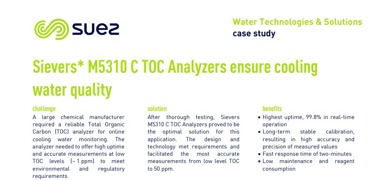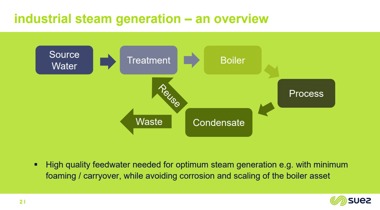Sum parameters: The relationship between common analytical tools– BOD, COD, & TOC
Introduction
Traditional analytical tools used to determine the pollution degree of water and wastewater are labbased tools that measure the oxygen demand required to oxidize contaminants. Biological Oxygen Demand (BOD) and Chemical Oxygen Demand (COD) are the traditional tools often utilized. BOD and COD measure the oxygen-depleting effects of waste contaminants. The exception to this standard is the measurement of Total Organic Carbon (TOC), which directly measures inorganic and organic carbon. Below is a summary of each parameter, what they measure, and general strengths and weaknesses.
Analytical tools
BOD, Biochemical Oxygen Demand What is measured BOD is an indicator of the fraction of organic matter that can be degraded by microorganisms, typically expressed as the amount (mg/L) of oxygen consumed over five days at 20°C. BOD includes the readily biodegradable organic carbon (carbonaceous or cBOD) and occasionally ammonia (nitrogenous or nBOD). cBOD is the primary driver of BOD and includes soluble, particulate, and colloidal organic carbon compounds. cBOD can be isolated by adding a nitrification inhibitor to prevent the oxidation of ammonia to nitrate. Weaknesses 1. Time: The BOD test requires five days which is too slow to provide timely information for control purposes.
2. Precision: BOD results normally have wide precision ranges on the order of +/-10-20%, showing limited reproducibility especially with treated waters.
3. Interferences: Wastes containing suppressors to microbiological activity can inhibit and limit BOD results. These include antibiotics, chlorine disinfection, sanitization products, and some salts.
4. Specificity: The application of BOD is specific to a single sample and is not linear.
COD, Chemical Oxygen Demand What is measured
COD is the amount of oxygen required for the chemical oxidation of compounds in water. This demand is determined using a strong oxidant, with most standard methods using dichromate and to a lesser extent permanganate. Dichromate does not oxidize ammonia to nitrate, so nitrification is not included in COD results. Much of the COD contribution is from soluble, particulate, and colloidal organic matter. However, additional oxygen demand is created by nitrite, bromide, iodide, sulfide, and some metal ions.
Weaknesses
1. Time: Typical COD tests require several hours which is better than BOD but too slow to provide timely information for control purposes.
2. Oxidation limitation: Some organic molecules (e.g., benzene) are relatively resistant to dichromate oxidation and may give a falsely low COD.
3. Inorganic carbon: The oxidation step does not distinguish between organic and inorganic carbons.
4. Additional inorganics: Chlorides, nitrite, ferrous iron, and sulfide may interfere with the COD measurement.
5. Hazardous chemicals: Dichromate is toxic due to its oxidizing power and its use is being restricted in Europe.
Although often discussed, there is no generalized correlation between COD and BOD.
It is possible for a specific waste stream to develop a correlation, but this cannot be applied to other waste contaminants or streams due to the variable nature of the wastewater’s composition.
TOC, Total Organic Carbon What is measured
TOC is a direct measure of all organic carbon in a sample. It is determined by oxidation of the organic carbon compounds. TOC analyzers can be configured to measure different fractions of organic carbon including: TOC, Purgeable Organic Carbon (POC), Non-purgeable Organic Carbon (NPOC) and Dissolved Organic Carbon (DOC).
Depending on the organic carbon technique employed, Inorganic Carbon (IC) is removed or measured.
Measuring for both inorganic carbon and organic carbon will provide Total Carbon (TC).
Strengths
1. Direct: TOC analyzers directly measure the amount of organic carbon without interferences or additional variables of BOD or COD methods.
2. Versatile: TOC analyzers come in a variety of configurations to measure specific fractions of carbon to produce the required information.
3. Time: TOC results can be obtained in less than 10 min.
4. Accuracy & Precision: TOC analysis often results in accuracy and precision within +/-5% over a large range of concentrations from 1 ppb to 50,000 ppm.
Weaknesses
1. TOC does not identify the overall oxidation state. Most regulations are still written for BOD and COD reporting.
Technology
The Sievers InnovOx TOC Analyzers with state of the art supercritical water oxidation (SCWO) provides accurate measurement of the carbonaceous component of oxygen demand and supports correlation to these methods. The advantages of measuring organic carbon with the Sievers InnovOx TOC Analyzer include:
1. No interference from Chlorides when measuring TOC
2. Less than 10-minute analysis time, supports laboratory and on-line applications
3. Complete oxidation of organic molecules unlike dichromate oxidation (COD)
4. Provides direct data on process performanceorganic load, separation, and removal
Conclusion
Water and wastewater samples contain a diverse set of organic contaminants. While COD, BOD, and TOC each provide information about the pollution degree of water and wastewater, only TOC provides a direct measure in minutes, allowing for process control and quick decision making. With the Sievers InnovOx TOC Analyzers and SCWO technology, you can obtain accurate data without interference on process performance.






